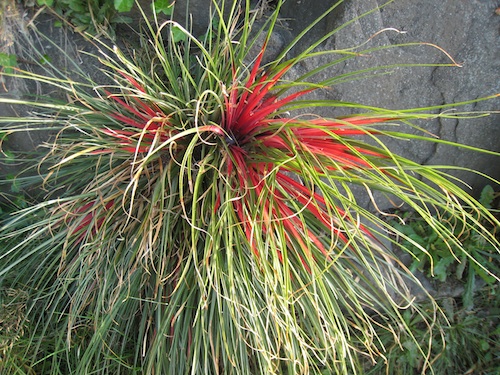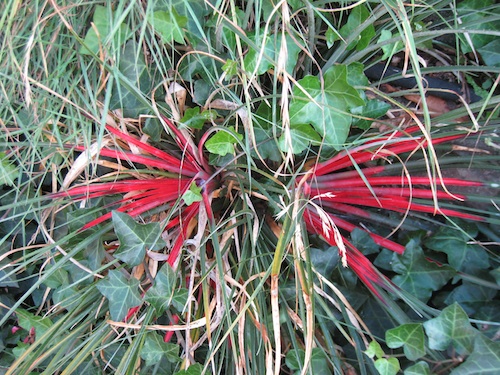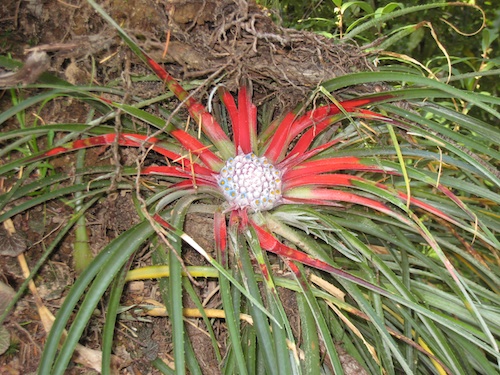Plant of the Month: October 2013
|
| Crimson or Sun Bromeliad |
| Fascicularia bicolor (Ruiz & Pav.) Mez 1894 |
| = Bromelia bicolor Ruiz & Pav. 1802 |
| = Billbergia bicolor (Ruiz & Pav.) Schult. & Schult. f. 1830 |
BROMELIACEÆ; Bromeliad Family
|
| At least 27 genera of bromeliads (i.e., members of the plant family BROMELIACEÆ) have been reported as suitable for testing indoors as houseplants, or interior plants, whether in a pot or upon a piece of bark, or whatnot. Of these 27 genera, 16 have members reported with edible parts; hence 59%. Nearly all bromeliad genera grow in subtropical or tropical Central and South America, and are cold-tender, meaning that freezes kill them. However, this month I feature one that in at least some of its specimens is frost-hardy. Moreover, it is beautiful, and edible. |
| Better known examples of edible bromeliad genera include: Æchmea, Ananas, Bromelia, Puya, Tillandsia, and Vriesia. But for the moment, I ignore them wholly. |
| The Chilean genus Fascicularia is the southernmost member of the whole family. There it is called Chupalla or Calilla; the Mapuche called the fruit el Poe. It has been seldom tried as a houseplant until the 1990s, and is in almost no books, however websites and blogs cite its limited use. The only species Fascicularia bicolor, consists of two subspecies. First is the typical version (often growing in rocky places near the coast), and second the subspecies named canaliculata E.C. Nelson & Zizka 1997 (usually a forest epiphyte). Some other species once ascribed to the genus have been placed into other genera. |
| In Seattle, where I live, I first saw some Fascicularia plants in a rockery in September 2009 --photo below. A few weeks later, I saw some growing outdoors and blooming at Heronswood Nursery, near Kingston, Washington. Most parts of the year, the plants are green, spiny and nondescript. But as they approach flowering stage, their leaves develop a rich red color of wonderful beauty, and then lovely pale blue flowers appear. I have not seen the fruit. |
| I am told that due to the spiny leaves, dividing the plants is a pain. I have not tasted the edible parts: the ripe fruit; the roots, and the tender young leaf bases. For information as to edibility, I consulted the 2005 book Especies Botánicas Consumidas por las Chilenos Prehispánicos by Oriana Pardo B. & José Luis Pizarro T. |
| Some gardeners have purchased specimens of Fascicularia that have been killed in cold winters. It is evident that several factors are involved: the plant's provenance; its growing conditions in a garden; and its condition or health. As with bromeliads in general, it requires good drainage, so is best planted on a wall, rockery, upturned roots or logs, rather than in the earth. It can handle sun or shade. |
| I think the specimens shown below, are subspecies canaliculata. That is the more cold-hardy one. But in the Heronswood Nursery 2000 catalog, Dan Hinkley wrote: "Fascicularia bicolor ssp. bicolor. There are many remarkable things that happen in one's garden, but having come to realize that this 'pineapple' is completely hardy for us in the Pacific Northwest is amongst the most incredible realizations I have thus far experienced in my life as a gardener. Leathery, spined grayish-green rosettes of foliage centered with shorter red-suffused leaves. Sky-blue flowers are attended by ivory-colored bracts in mid- to late summer on stems rising to 15 inches." Cistus Nursery, near Portland, Oregon, has also sold specimens labeled Fascicularia bicolor ssp. bicolor. |
| It has naturalized in western Ireland, the Isles of Scilly, West Cornwall, and the Channel Islands. |
Ron Brightman shared with me that some cultivated specimens of Fascicularia bicolor have been miscalled Fascicularia pitcairniifolia, a name that -- used correctly-- is a synonym of the closely related Ochagavia litoralis (Phil.) Zizka, Trumpler & Zšllner 2002, a species from rocks and steep cliffs of coastal central Chile, that differs in its shorter, wider leaves; rose colored petals; exserted stamens; and smaller fruit.
|
For more information, you may care to consult Revision of the genus Fascicularia Mez (Bromeliaceae) in Botanical Journal of the Linnean Society Vol. 129 (1999) pages 315-332 by Georg Zizka et al.
Back
|

Fascicularia bicolor; photo by ALJ
|

Fascicularia bicolor with ivy; photo by ALJ
|

Fascicularia bicolor in bloom; photo by ALJ
|
|
|

